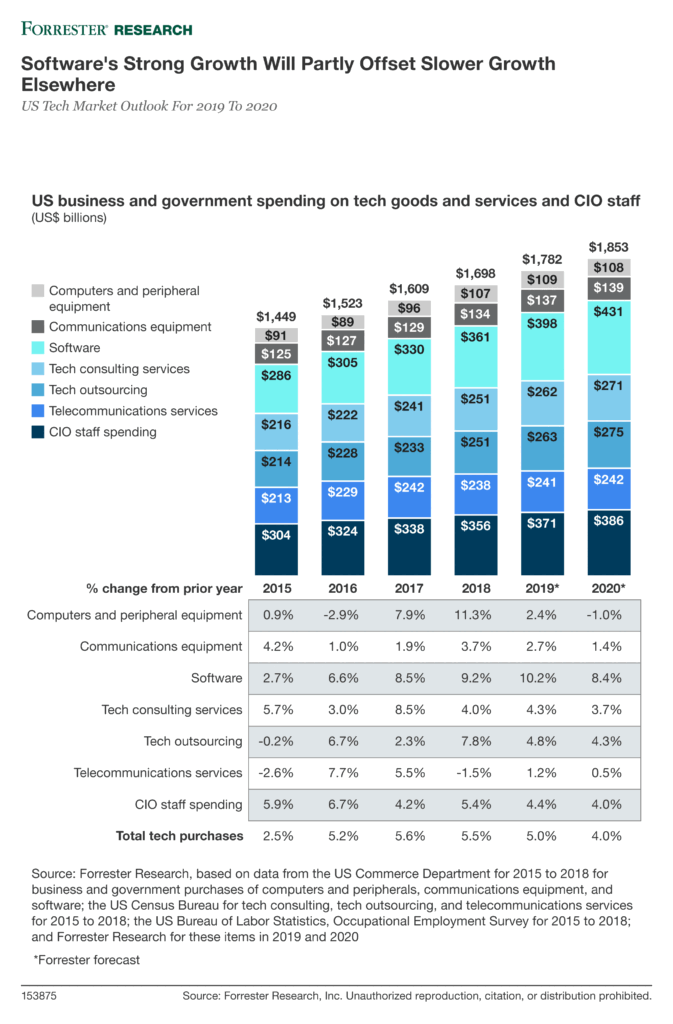US Tech Spending Slowdown Amid Rising Cloud Adoption Will Squeeze Tech Budgets
Recent stock and bond market turmoil has highlighted the growing risk of a US economic slowdown and even a recession — a prospect that 74% of economists think will happen by 2021, according to a survey of US economists by the National Association for Business Economics. We at Forrester are not quite as pessimistic. But in our just-published forecast for the US tech market (“US Tech Market Outlook For 2019 To 2020: Slowing Economic Growth And Rising Cloud Will Squeeze CIO Options“), we do expect that a slowing US economy will lead to US tech budget growth decreasing from almost 6% in 2017 and 2018 to 5% in 2019 and 4% in 2020. At the same time, spending on software — and especially cloud software — will continue to rise strongly.
Here are the key takeaways from our updated forecast:
- Total US tech budgets will grow by 5% in 2019 and 4% in 2020, reaching $1.85 trillion. While slower than US tech spending growth in 2017 and 2018, these growth rates are still relatively strong. But there are more downside risks than upside potential. Trade wars, weaker overseas economies, and changing US government policies make manufacturers leery of making new investments and hurt US exports. While US consumer spending is still solid thanks to low unemployment and low interest rates, the housing sector is falling, and consumers could get spooked if stock markets fall and manufacturers start cutting back on hiring.
- Software drives US tech spending. Software is not only the largest category of US tech budgets; it is also the fastest-growing, with increases of 10% in 2019 and 8% in 2020. The main cause of this growth is the US shift to cloud software, especially multitenant SaaS. Demand for front-office sales, marketing, and customer service software is especially strong, as firms invest to capture their share of continuing economic growth. Demand is also rising for back-office software for finance, HR, purchasing, risk management, and core transaction systems. But the shift to cloud will bring a worrisome challenge for CIOs, as the subscription fees for their cloud software keep rising at a time when their firms’ revenues are starting to slow.
- Tech consulting and systems integration services and tech outsourcing services also benefit from the shift to cloud. The increases in software spending will fuel purchases of tech consulting and systems integration services, which help firms implement, secure, and get value from their software investments. Businesses and governments are also taking advantage of cloud infrastructure and platform services. But in both cases, market gains from cloud will be offset in part by weak or declining demand for systems integration services to implement on-premises software and traditional hosting and outsourcing services.
- Tech staff spending will grow steadily. Average tech staff salaries will grow at 2% to 3% rates, and the number of tech workers will increase at similar rates.
- Hardware and telecommunications services will get squeezed. The combination of rising spending on cloud and slowing revenues will put pressure on the other categories of computer equipment, communications equipment, and telecommunications services. A tax-related boom in computer equipment in late 2017 and 2018 has come to an end, with growth slowing to 2.5% in 2019 and dropping in 2020. Communications equipment spending growth will slow to under 3% in 2019 and under 1.5% in 2020. And spending on voice and data wireless and wired telecom services will expand by around 1% each year.

